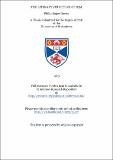Files in this item
The literary structure of 1QM
Item metadata
| dc.contributor.advisor | Black, Matthew | |
| dc.contributor.advisor | McKane, William | |
| dc.contributor.author | Davies, Philip R. | |
| dc.coverage.spatial | iv, 200 p. | en_US |
| dc.date.accessioned | 2018-05-24T09:42:18Z | |
| dc.date.available | 2018-05-24T09:42:18Z | |
| dc.date.issued | 1973-01 | |
| dc.identifier.uri | https://hdl.handle.net/10023/13517 | |
| dc.description.abstract | Previous research on the Qumran scrolls, and in particular, IQM, has only recently involved the use of the most stringent literary - and form - critical techniques. These are of great value to Qumran studies; the history of the sect and its ideas can be learnt only when the texts are properly understood. IQM has been recognised by most scholars as a composite work, and XV-XIX has long been regarded as a unit. To this must be added II-IX which also comprises a single document. Both these documents are themselves composite. II-IX is a war-rule written in the Hasmonean period, and drawing on sources which originated in the Maccabean and immediate post Maccabean period. XV-XIX is a dualistic war-rule, which has developed from an earlier non-dualistic rule, of which col. XIV, 2-16a represents a small fragment. Cols. X-XII consist of a collection of liturgical pieces which have been found to reflect a Maccabean context in many cases. Col. XIII represent a fragment of liturgy probably associated with a covenant ceremony. Cols. II-IX, X-XII, XIII, XIV, and XV-XIX were collected and probably copied together; XV, 4-6a seems to refer to two documents which were independent at the time of writing, but have subsequently been incorporated into IQM - these are identified as II-IX and X-XII. XIII and XIV existed as fragments when they were brought together with the rest of the material from cols. II-IX, X-XII and XV-XIX. XV-XIX probably attained its present form in the second half of the first century B.C. In the first half of the first century A.D. a compiler produced from the collected documents a war-rule which included an introduction (col. I) written by the compiler. The final result is the War Scroll, the manuscript of which was written soon after the composition (= IQM). Its purpose is to prepare for the imminent war against the Romans. | en_US |
| dc.language.iso | en | en_US |
| dc.publisher | University of St Andrews | |
| dc.subject.lcc | BM487.D2 | en |
| dc.subject.lcsh | Dead Sea scrolls. 4Q. | en |
| dc.title | The literary structure of 1QM | en_US |
| dc.type | Thesis | en_US |
| dc.type.qualificationlevel | Doctoral | en_US |
| dc.type.qualificationname | PhD Doctor of Philosophy | en_US |
| dc.publisher.institution | The University of St Andrews | en_US |
This item appears in the following Collection(s)
Items in the St Andrews Research Repository are protected by copyright, with all rights reserved, unless otherwise indicated.

